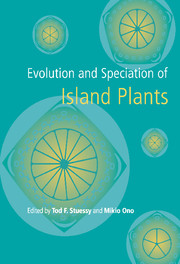Book contents
- Frontmatter
- Contents
- List of contributors
- Preface
- Acknowledgements
- Part one Hawaiian Islands
- Part two Juan Fernandez Islands
- Part three Southern and western Pacific Islands
- Part four General evolutionary patterns and processes on oceanic islands
- Introduction
- 11 Secondary compounds and evolutionary relationships of island plants
- 12 Chromosomal stasis during speciation in angiosperms of oceanic islands
- 13 The current status of our knowledge and suggested research protocols in island archipelagos
- Author index
- Taxon index
- Subject index
12 - Chromosomal stasis during speciation in angiosperms of oceanic islands
Published online by Cambridge University Press: 04 May 2010
- Frontmatter
- Contents
- List of contributors
- Preface
- Acknowledgements
- Part one Hawaiian Islands
- Part two Juan Fernandez Islands
- Part three Southern and western Pacific Islands
- Part four General evolutionary patterns and processes on oceanic islands
- Introduction
- 11 Secondary compounds and evolutionary relationships of island plants
- 12 Chromosomal stasis during speciation in angiosperms of oceanic islands
- 13 The current status of our knowledge and suggested research protocols in island archipelagos
- Author index
- Taxon index
- Subject index
Summary
Abstract
Speciation in angiosperms is often accompanied by change in chromosome number via euploidy or aneuploidy. Evolution involving autopolyploidy and to a much greater extent allopolyploidy has been documented on numerous occasions. In fact, it is estimated that more than 60% of angiosperms exist at the polyploid level, having resulted from many different allopolyploid reticulate evolutionary events. Evolution via aneuploidy is also common, with both ascending and descending modes known (the latter more common, however). Stimuli for rapid chromosomal evolution include intertaxon hybridization and rapid environmental change. Floras of oceanic islands contain numerous endemic taxa which have evolved from continental ancestors and often have further speciated within the archipelago. Chromosomal surveys of the Hawaiian, Juan Fernandez, Bonin and Galapagos Islands reveal very little change in chromosome number during the evolution of endemic taxa, even though speciation is often accompanied by marked morphological divergence. More continental islands, such as the Queen Charlotte Islands, and older oceanic islands closer to mainland sources, for example the Canary Islands, likewise reveal patterns of chromosomal variation. Explanations for absence of change in chromosome number on oceanic islands include low levels of hybridization due to habitat exclusion of endemic taxa, short periods of geological time and selection against aneuploid cytotypes which might disrupt the adaptive complex of traits that led to successful establishment, colonization and radiation.
Speciation in angiosperms is often accompanied by change in chromosome number via euploidy or aneuploidy.
- Type
- Chapter
- Information
- Evolution and Speciation of Island Plants , pp. 307 - 324Publisher: Cambridge University PressPrint publication year: 1998
- 26
- Cited by



